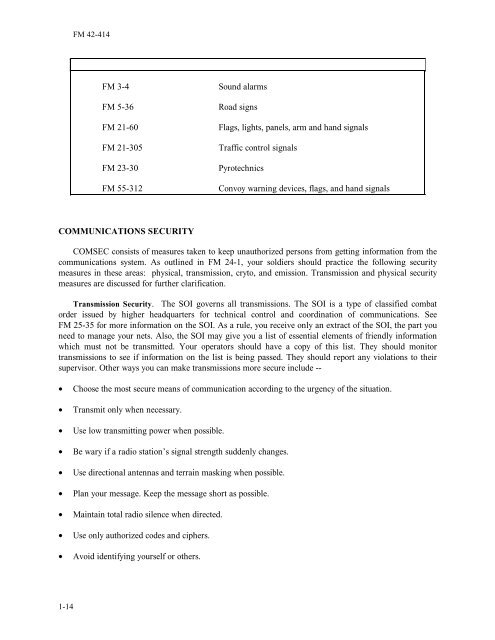Tactics, techniques, and procedures for - Army Electronic ...
Tactics, techniques, and procedures for - Army Electronic ...
Tactics, techniques, and procedures for - Army Electronic ...
Create successful ePaper yourself
Turn your PDF publications into a flip-book with our unique Google optimized e-Paper software.
1-14<br />
FM 42-414<br />
FM 3-4 Sound alarms<br />
FM 5-36 Road signs<br />
FM 21-60 Flags, lights, panels, arm <strong>and</strong> h<strong>and</strong> signals<br />
FM 21-305 Traffic control signals<br />
FM 23-30 Pyrotechnics<br />
FM 55-312 Convoy warning devices, flags, <strong>and</strong> h<strong>and</strong> signals<br />
COMMUNICATIONS SECURITY<br />
COMSEC consists of measures taken to keep unauthorized persons from getting in<strong>for</strong>mation from the<br />
communications system. As outlined in FM 24-1, your soldiers should practice the following security<br />
measures in these areas: physical, transmission, cryto, <strong>and</strong> emission. Transmission <strong>and</strong> physical security<br />
measures are discussed <strong>for</strong> further clarification.<br />
Transmission Security. The SOI governs all transmissions. The SOI is a type of classified combat<br />
order issued by higher headquarters <strong>for</strong> technical control <strong>and</strong> coordination of communications. See<br />
FM 25-35 <strong>for</strong> more in<strong>for</strong>mation on the SOI. As a rule, you receive only an extract of the SOI, the part you<br />
need to manage your nets. Also, the SOI may give you a list of essential elements of friendly in<strong>for</strong>mation<br />
which must not be transmitted. Your operators should have a copy of this list. They should monitor<br />
transmissions to see if in<strong>for</strong>mation on the list is being passed. They should report any violations to their<br />
supervisor. Other ways you can make transmissions more secure include --<br />
• Choose the most secure means of communication according to the urgency of the situation.<br />
• Transmit only when necessary.<br />
• Use low transmitting power when possible.<br />
• Be wary if a radio station’s signal strength suddenly changes.<br />
• Use directional antennas <strong>and</strong> terrain masking when possible.<br />
• Plan your message. Keep the message short as possible.<br />
• Maintain total radio silence when directed.<br />
• Use only authorized codes <strong>and</strong> ciphers.<br />
• Avoid identifying yourself or others.

















